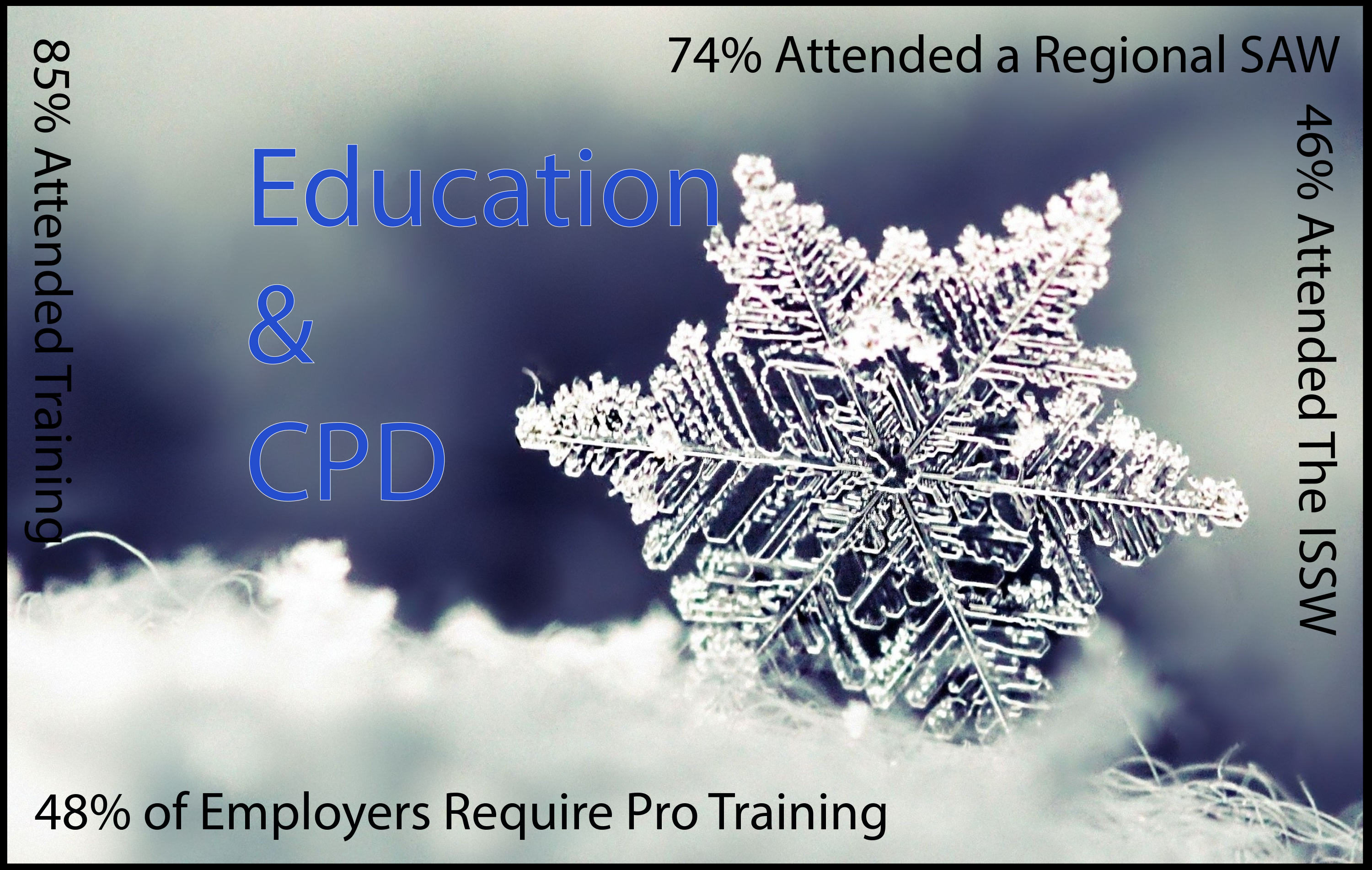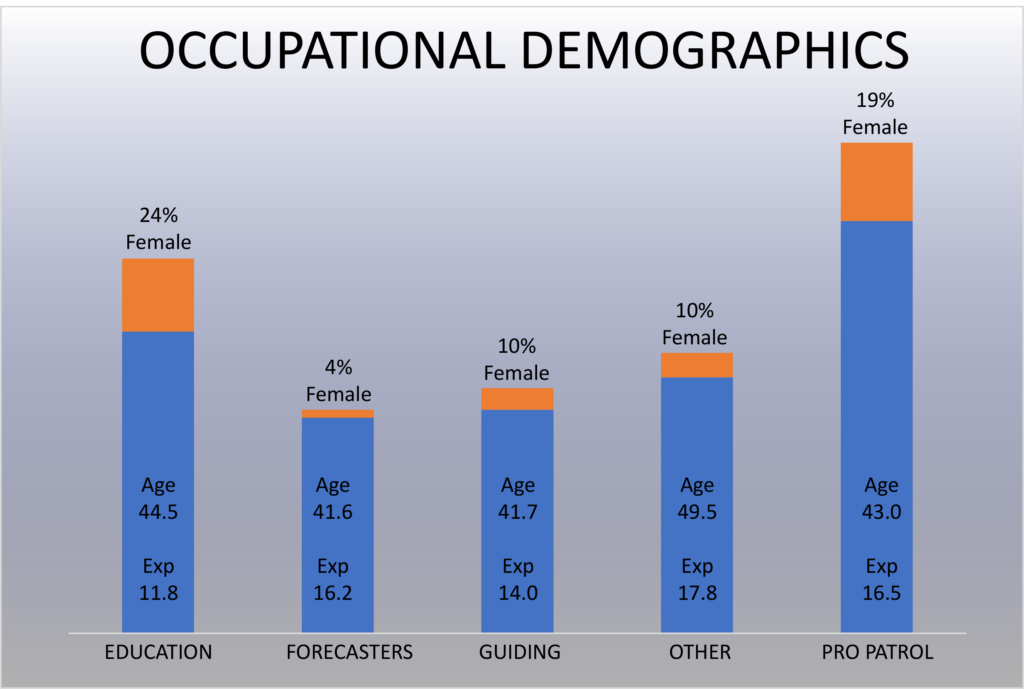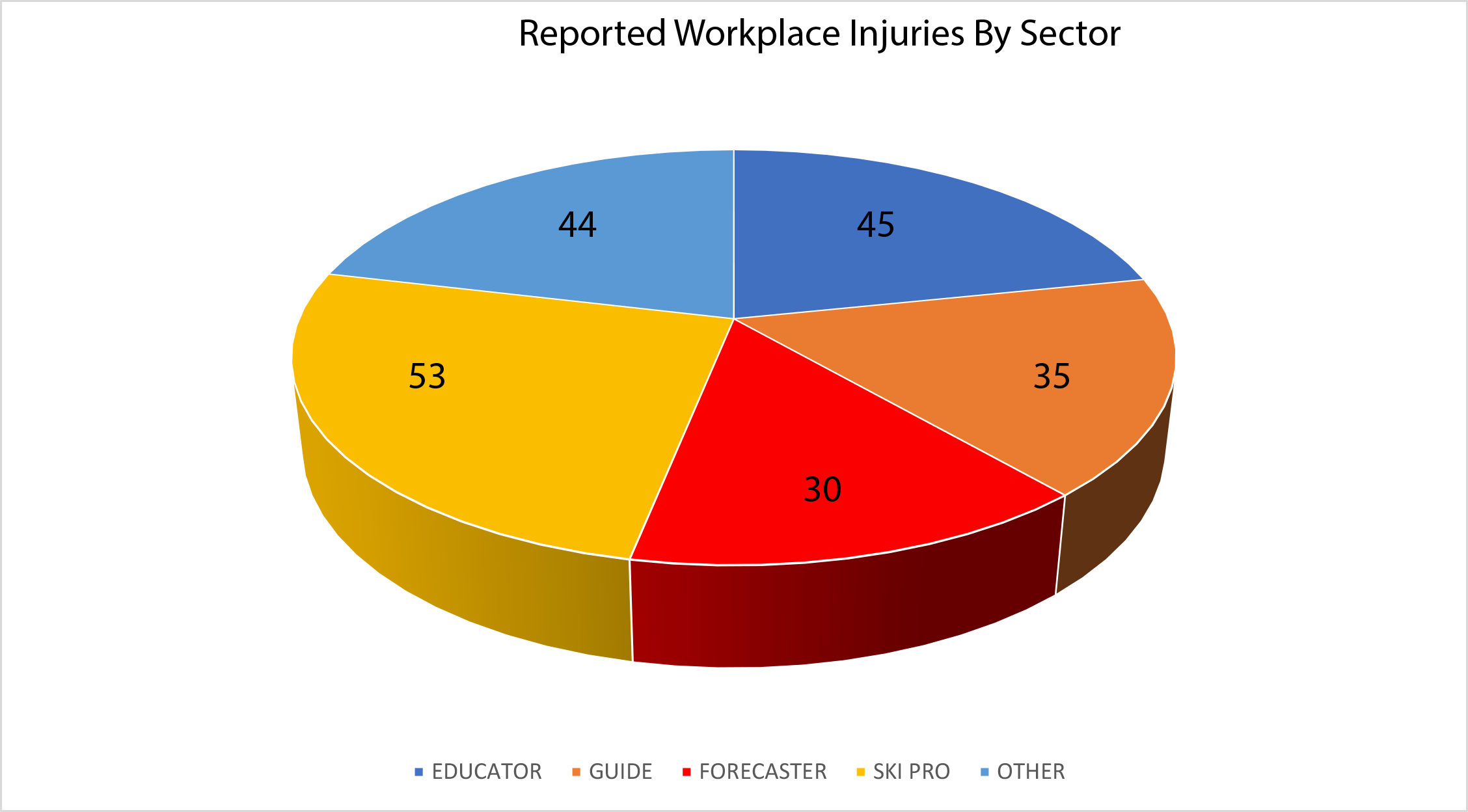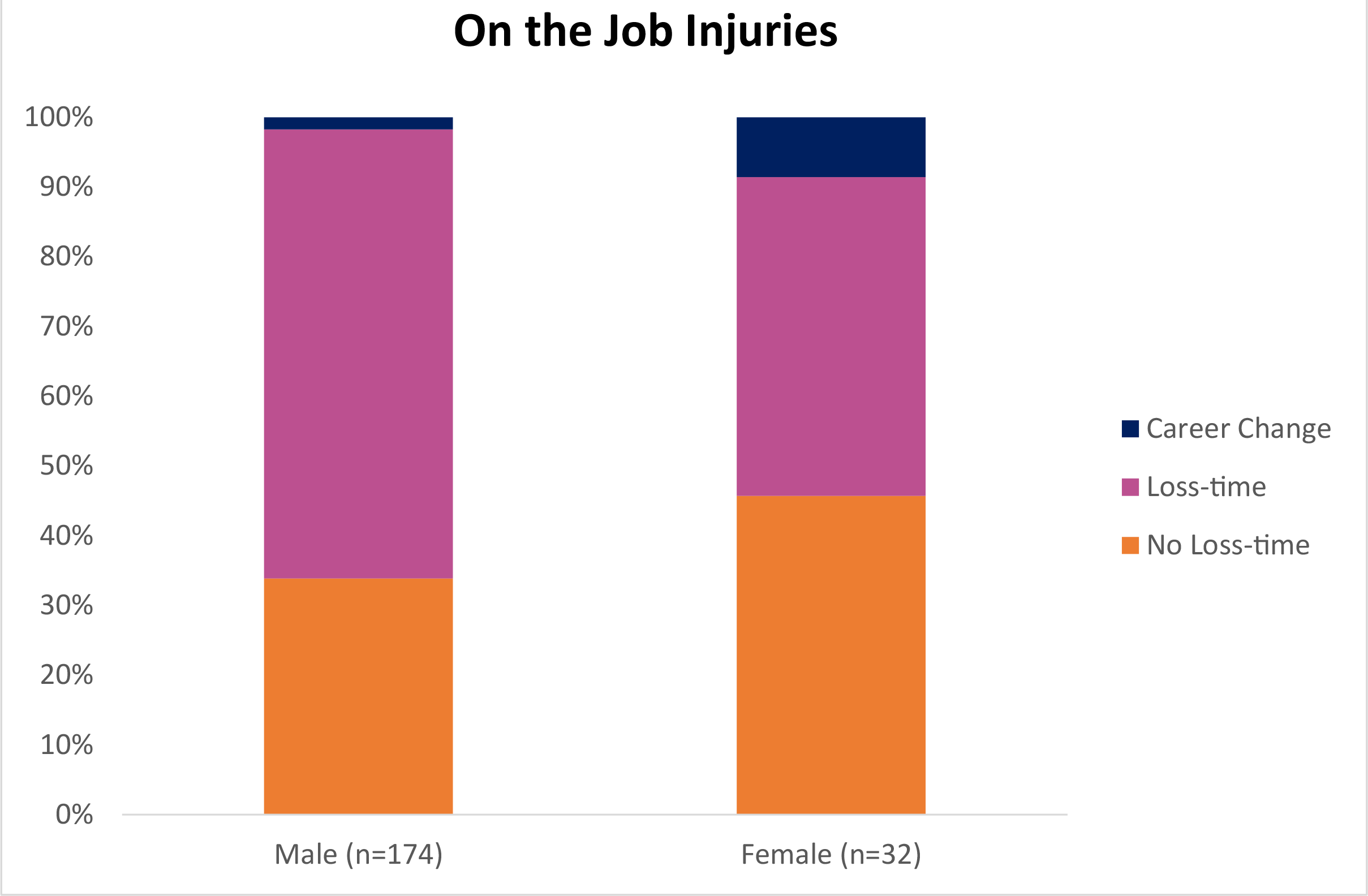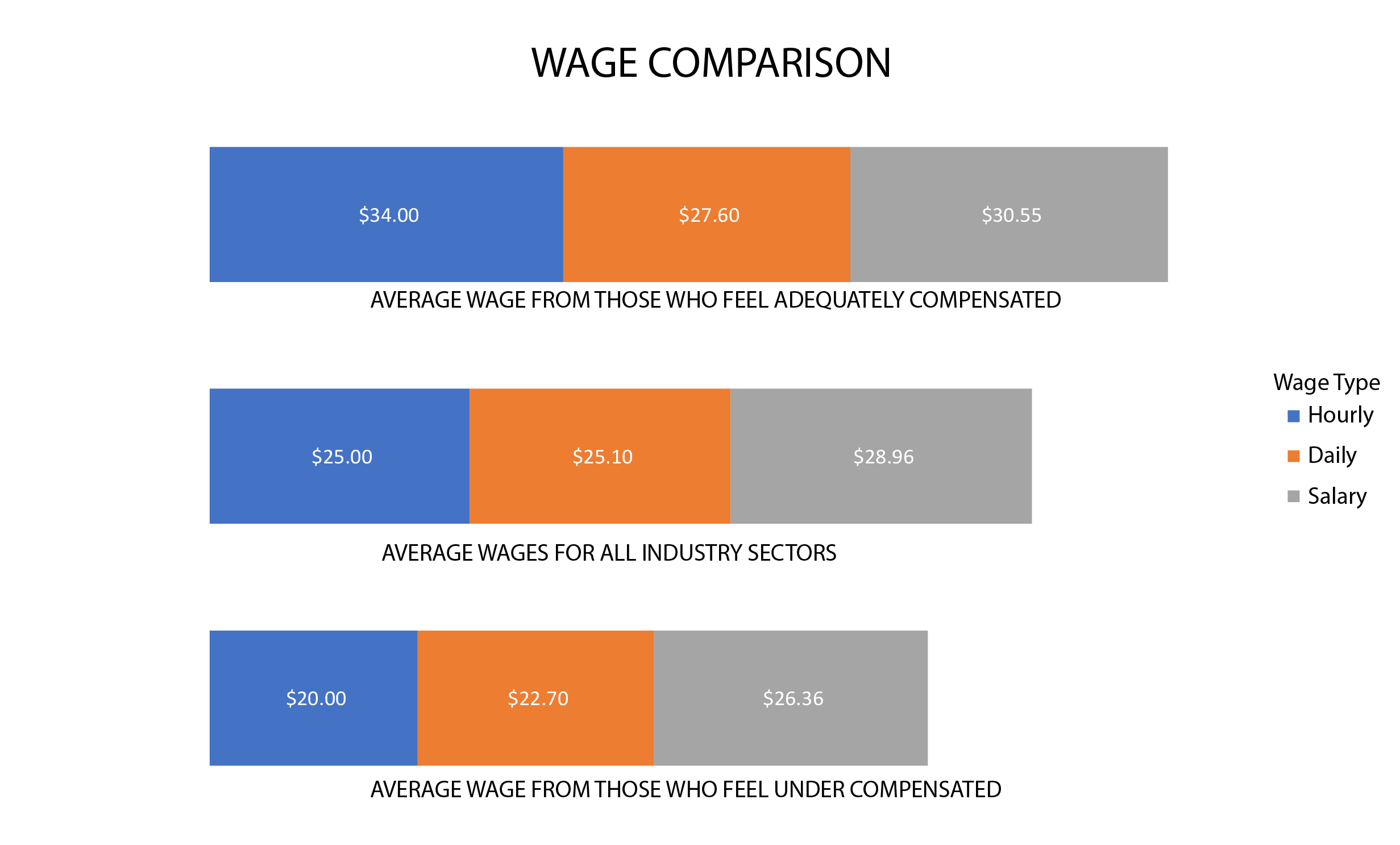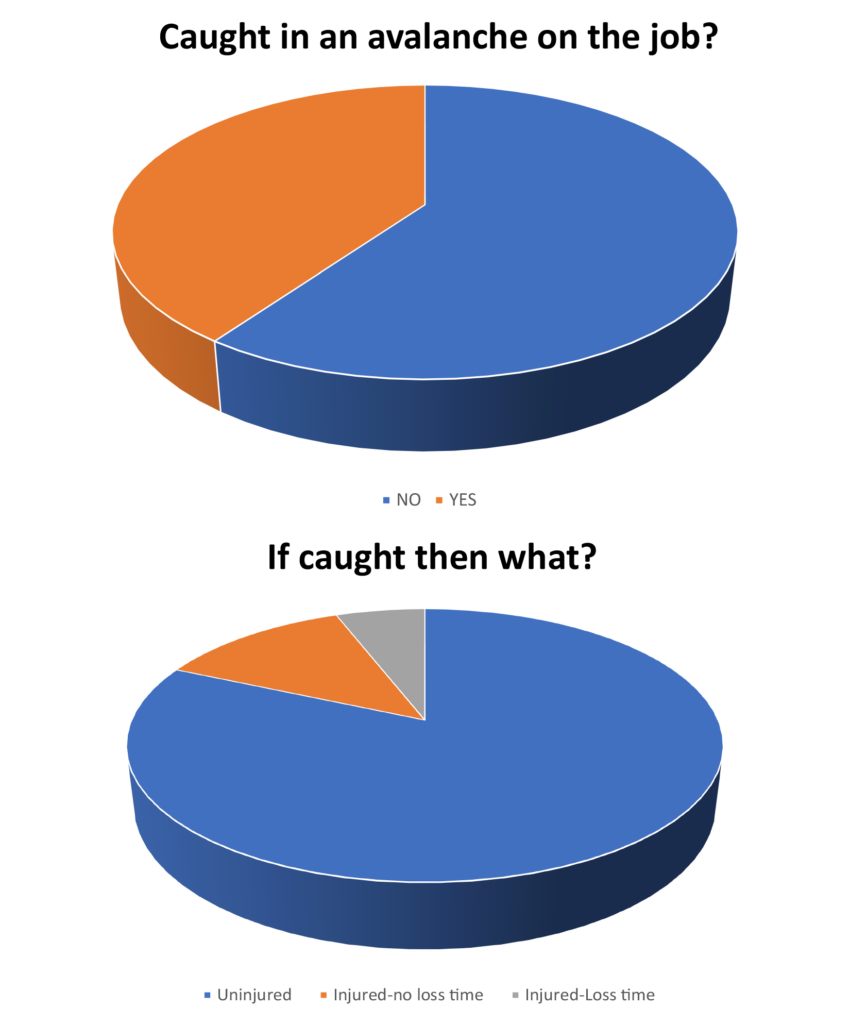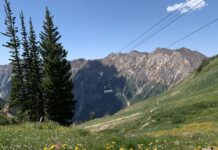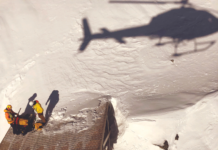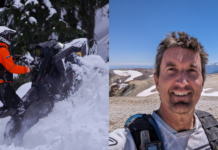By Katie Warren, Eeva Latosuo, John Stimberis, & Halsted Morris
To promote diversity, recruitment, retention, and professional development in the avalanche industry, it is necessary to understand the industry averages regarding wages, injury rates, and other factors that influence working conditions. We developed a comprehensive survey that was distributed through various channels in the avalanche industry to collect data on these demographics for avalanche professionals in the United States. Understanding these factors and how they compare with other industries helps to focus attention on areas of the industry in need of improvements, such as minimum professional avalanche education requirements and benefits enrollment availability. It is also vital for identifying causes and working on solutions for the lack of diversity within the industry.
We have minimal data about the demographics of the avalanche industry. The American Avalanche Association website once contained a page titled “So you want an avalanche job,” where one could find a rough guess about the number of people employed in various sectors of the industry. Previously conducted surveys investigated specific subjects within the avalanche industry. We designed this survey to investigate a broad scope of demographics, working conditions, and professional training requirements within the industry. The survey included common demographic questions for all industries and focused on work-related questions specific to the avalanche industry. The survey was open for responses from November 2019 through February 2020.
Results
The survey generated 628 responses (n=628), of these responses, 105 respondents began the survey but did not complete all questions; 523 (n=523) completed the survey in its entirety. For consistency of data analysis, only completed responses are included in the analytical data set, n=523. The organic method of survey distribution prohibits the calculation of a response rate. Comparing the number of responses to the total number of professional members of The American Avalanche Association reveals that the survey reached 34% of the professional group. Survey participants represented avalanche professionals from all employment sectors and regions across the United States. While all regions likely to employ avalanche professionals responded, higher percentages of responses arrived from regions where participation in winter recreation activities tends to be more significant, or avalanche activity has the potential to affect essential transportation corridors. Responses also included a wide range of experience; however, most participants had been in the industry for 20 years or less. The highest responding professions were professional ski patrollers (n= 153) and recreational avalanche educators (n=112), followed by avalanche forecasters (n=80) and winter guides (n=83). “Other” (n=95) category represented a catchall of remaining responses.
Diversity
The results indicate that the avalanche industry is not a diverse workplace. Avalanche professionals are likely to be of White or Caucasian ethnicity (92%) and identify as male (85%). The data indicated that a lower percentage of women professionals was consistent for all types of avalanche related employment. Avalanche education was the only type of employment that showed a slightly higher percentage of women (24%). A significantly lower percentage of women work as guides (10%) and avalanche forecasters (3%). These data also indicate a lower retention rate for women in the industry.
Workplace Injuries
Workplace injuries occurred for 40% of avalanche professionals; of those workplace injuries, 66% resulted in a loss of work time or forced a career change. Overall, that results in 26% of avalanche professionals experiencing a workplace injury that results in a loss of work time or career change.
Wages and Compensation
The average hourly, daily, and monthly wages for all avalanche professionals are $25, $251, and $5,039, respectively, and less than half of surveyed avalanche professionals responded that their compensation is adequate for the work they perform. On average, respondents that feel adequately compensated make over 15% percent more than those that do not feel adequately compensated.
Benefits and Equipment
Most respondents, 59%, do not receive any benefits from the employer. When employers provide benefits, it is most likely a retirement account, followed by medical insurance, and then dental insurance. Only 39% of respondents receive an equipment allowance at an average of $240, and employers only provide personal avalanche safety equipment (transceiver, shovel, probe) for about half of the professionals. Avalanche airbags are part of the employer-provided kit for 44% of the respondents. Still, four in ten participants need to purchase avalanche safety equipment for themselves.
Education and Development
Four in ten avalanche professionals have acquired a reasonably high level of formal avalanche training for their jobs, and only three percent have no avalanche training at all. Results reflect the transition time for professional avalanche training in the U.S., and the respondents could include all the courses they have taken.
There are significant differences in training levels between industry segments; guides and educators have an obvious training path, unlike ski area workers that represent more varied training levels. A third of the employers do not specify any training level requirements for workers. The most common requirement was Pro 1, followed by (former) Level 3, and Pro 2. Of the 97% attending courses, nearly half of avalanche professionals receive some form of compensation for attendance.
The data also contains information about continuing professional development (CPD), and compensation. Employee commitment is prevalent among avalanche professionals, often beyond the requirements of a position or compensation. Avalanche workers regularly attend CPD on a regional or international scale. 74% attended a regional snow avalanche workshop (SAW), and 46% attended the International Snow Science Workshop (ISSW) at least once. Employer commitment to CPD compensation, either through wages or travel, is relatively low, with approximately 27% of employers providing compensation for wages or travel to ISSW and 32% for regional SAWs.
Discussion
Avalanche professionals work in highly variable and challenging conditions, where current weather and snowpack have a significant influence on the work environment. While personal decision-making is often considered as the most influential factor in avalanche worker injuries, considering the organizational culture and complexity of the workplace could help identify accident causation and reduce future workplace incidents. This survey attempted to investigate on-the-job injuries as a whole and for different occupations within the industry. These data suggest that approximately one out of four avalanche professionals may experience a workplace injury resulting in loss of time or a career change. Further research is necessary to understand if this high percentage of worker injuries combined with relatively low wages is a factor that influences retention rates within the industry.
The results from this survey indicate poor retention of female avalanche professionals. Previous research in other male-dominated fields has also shown a high rate of attrition, similar to our
results. Family obligations did not seem to explain female attrition in other fields, and they also may not explain why women tend to leave the avalanche industry. The argument that the masculine subculture is influencing a negative work experience for women in these male-dominated careers may also apply to the avalanche industry (The full-length article will expand on these topics). For example, data from our research indicates that a higher percentage of women work in avalanche education. Education may be often viewed as a feminine role, that women have a better perception of fit, more advancement opportunities, and encounter less backlash while ascribing to the perceived feminine role of an educator.
Continuing professional development is readily available to those in the avalanche industry. American Avalanche Association membership includes access to publications containing a variety of pertinent avalanche-related content. Regional and international workshops provide additional state of the art presentations, published proceedings, and the opportunity to network with fellow professionals. Training and CPD take time and money, so there is the matter of compensation related to professional membership and CPD attendance, and whether participation in these events provides additional job benefits. The discrepancy between employer requirements and actual formal training levels could indicate that employers place more value upon the in-house training programs and the competencies acquired through the years of work experience more than formalized training courses or standards.
Conclusion
This survey is a preliminary investigation into demographics and employee standards for the American avalanche industry. The avalanche industry suffers from a significant lack of diversity, possibly limiting the potential for improvement due to a lack of varied perspectives from a diverse professional group. Despite the lack of employer incentives, most avalanche professionals are highly committed to pursuing continuing professional development and education. If employers were provided more incentives or financial support to employees for these, it might increase the industry standard, while also encouraging retention and allowing for individual professional growth.
We wish to thank the American Avalanche Association Executive Board, everyone who assisted in the creation of the survey, and all of the avalanche professionals who responded to the survey.
About the Authors
Katie Warren serves on the A3 board of directors as Secretary. She works as a ski patroller at Stevens Pass, part-time for the WSDOT HWY 2 avalanche program, and teaches avalanche courses for Cascade Powder Guides.
Eeva Latosuo just wrapped up a sabbatical year as Associate Professor of Outdoor Studies, Alaska Pacific University. She has continued curiosity towards equity in outdoor professions. She lives and works on Dena’ina lands in Anchorage, Alaska.
John Stimberis is the avalanche program manager for WSDOT South Central Region. He is currently working towards a Master’s of Science in Engineering at the University of WA. John lives in Seattle and desperately awaits the return of live music. He is a past president of the A3.
Halsted Morris got his nickname of “Hacksaw,” while he was with the Loveland Ski patrol, when one senior ski patroller couldn’t seem to remember his actual name, and the nickname stuck. Hacksaw has had a long career with A3; now he serves as the A3 President.

